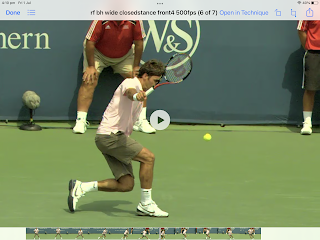This are Tony's one handed Backhand. Its a beautiful shot with lots of great elements in common to all the pros one handers. However after studying the videos we can be aware of some things that could make the shot more consistent.
When analyzing videos its good to see lots of different videos to better know your patterns on different shots. Would be great to see your videos from a different angle too, perhaps on a future post!
I've uploaded 7 shots. The first video and video number 6 are the worst shots. You were extremely late on both. Shots 2,3,4,5 are ok but could be better!. Shot number 7 is the best and could be better as well.
Before analyzing your videos one by one and point out where they differ from each other is good to point out first the elements that were common to all the videos. That way we can have a general understanding of this great one handed backhand.
The first thing that I noticed is how your hands stay very low during the first stages of the preparation. As you first step back with your left foot, your hands are still low and your racquet is very horizontal. This next picture is the moment the ball bounces on the court. This is one of the most important moments of all the players shots. I like to call it the power position.
Pic 1
You have the weight of the body on the left foot and you are about to step in to the ball with your right foot transferring all your body weight to the front foot. You have rotated your shoulders to the net, but you could have rotated a bit more, maybe 10 to twenty per cent more. The great problem of this position is that you haven't used the rotation of your shoulders to prepare the racquet to start your forward swing. You are going to raise your racquet higher than your head and your left and right hands are going up. All of this happens after the ball bounce which is a big problem. No wonder you were late on this shot!
See the next picture to see the point of your whole swing where your racquet and hands were higher:
Pic 2
If you look at those last two pictures you can see the major element you can improve on your one hander: LATE PREPARATION!!
Focus on those two pictures and imagine you could maintain the hands and racquet where they are on the second picture with the same feet position of the first picture. That is how you could be by the time the ball bounces on your side. Your power position.
You could probably lower the right hand more and keep the racquet more vertical and closer to the head like Federer, but there is nothing wrong in having the racquet where you have it as long as you get it there earlier. As I mentioned before, the fact that you've started your preparation with your hands and racquet low doesn't help either because you are elevating your hands and racquet too much and that costs you too much time.
You have a big swing, your racquet goes higher than your head. It is possible to have a big swing like that, but you have to make sure that your hands and racquet reach that position about the same time that the ball bounces!
These last two pictures are taken from Video number 1. By looking at picture two you can see how much higher the racquet is in relation to the ball. You still need to drop the racquet, get to the trigger position, and hit the ball in front. Problem is that the ball is not waiting for you to do all that!!
Because you are late on your preparation, that makes you step back a lot to gain time. If you look at those two pictures again notice how your left foot is actually pointing backwards on an angle even on the first pic. Its like your feet already knew that you were late on pic 1 and were preparing your body for that late shot. Notice that from picture 1 to picture two, your right foot has stepped back closer to the back fence than it was on pic one.
1
This next shot, you had to hit an open stance Backhand because you were running late. Although your racquet seems a bit more vertical on the moment the ball bounces your rotation is not good enough and your body weight is back towards the back fence. Then after the ball bounce you raise the racquet and specially the right hand which makes your shot become more difficult to execute. You open up your stance which in this case is a good idea since you are running so late.
2
And that's it Tony, great backhands. I love the follow through, the left hand back on the finish, the head still at contact, the right arm fully extended at contact. Preparation and footwork are the key elements to improve your backhands. Cant wait to see your new improved weapon!






































































